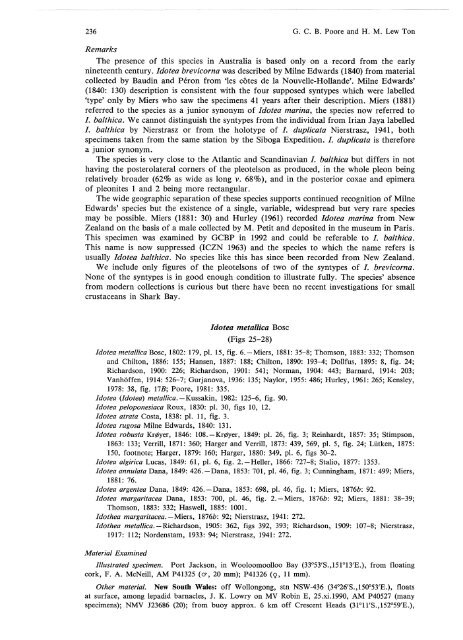Idoteidae of Australia and New Zealand (Crustacea: Isopoda: Valvif ...
Idoteidae of Australia and New Zealand (Crustacea: Isopoda: Valvif ...
Idoteidae of Australia and New Zealand (Crustacea: Isopoda: Valvif ...
You also want an ePaper? Increase the reach of your titles
YUMPU automatically turns print PDFs into web optimized ePapers that Google loves.
236 G. C. B. Poore <strong>and</strong> H. M. Lew Ton<br />
Remarks<br />
The presence <strong>of</strong> this species in <strong>Australia</strong> is based only on a record from the early<br />
nineteenth century. Idotea brevicorna was described by Milne Edwards (1840) from material<br />
collected by Baudin <strong>and</strong> Peron from 'les cotes de la Nouvelle-Holl<strong>and</strong>e'. Milne Edwards'<br />
(1840: 130) description is consistent with the four supposed syntypes which were labelled<br />
'type' only by Miers who saw the specimens 41 years after their description. Miers (1881)<br />
referred to the species as a junior synonym <strong>of</strong> Idotea marina, the species now referred to<br />
I. balthica. We cannot distinguish the syntypes from the individual from Irian Jaya labelled<br />
/. balthica by Nierstrasz or from the holotype <strong>of</strong> /. duplicata Nierstrasz, 1941, both<br />
specimens taken from the same station by the Siboga Expedition. I. duplicata is therefore<br />
a junior synonym.<br />
The species is very close to the Atlantic <strong>and</strong> Sc<strong>and</strong>inavian 7. balthica but differs in not<br />
having the posterolateral corners <strong>of</strong> the pleotelson as produced, in the whole pleon being<br />
relatively broader (62% as wide as long v. 68%), <strong>and</strong> in the posterior coxae <strong>and</strong> epimera<br />
<strong>of</strong> pleonites 1 <strong>and</strong> 2 being more rectangular.<br />
The wide geographic separation <strong>of</strong> these species supports continued recognition <strong>of</strong> Milne<br />
Edwards' species but the existence <strong>of</strong> a single, variable, widespread but very rare species<br />
may be possible. Miers (1881: 30) <strong>and</strong> Hurley (1961) recorded Idotea marina from <strong>New</strong><br />
Zeal<strong>and</strong> on the basis <strong>of</strong> a male collected by M. Petit <strong>and</strong> deposited in the museum in Paris.<br />
This specimen was examined by GCBP in 1992 <strong>and</strong> could be referable to I. balthica.<br />
This name is now suppressed (ICZN 1963) <strong>and</strong> the species to which the name refers is<br />
usually Idotea balthica. No species like this has since been recorded from <strong>New</strong> Zeal<strong>and</strong>.<br />
We include only figures <strong>of</strong> the pleotelsons <strong>of</strong> two <strong>of</strong> the syntypes <strong>of</strong> I. brevicorna.<br />
None <strong>of</strong> the syntypes is in good enough condition to illustrate fully. The species' absence<br />
from modern collections is curious but there have been no recent investigations for small<br />
crustaceans in Shark Bay.<br />
Idotea metallica Bosc<br />
(Figs 25-28)<br />
Idotea metallica Bosc, 1802: 179, pi. 15, fig. 6.-Miers, 1881: 35-8; Thomson, 1883: 332; Thomson<br />
<strong>and</strong> Chilton, 1886: 155; Hansen, 1887: 188; Chilton, 1890: 193-4; Dollfus, 1895: 8, fig. 24;<br />
Richardson, 1900: 226; Richardson, 1901: 541; Norman, 1904: 443; Barnard, 1914: 203;<br />
Vanh<strong>of</strong>fen, 1914: 526-7; Gurjanova, 1936: 135; Naylor, 1955: 486; Hurley, 1961: 265; Kensley,<br />
1978: 38, fig. 175; Poore, 1981: 335.<br />
Idotea {Idotea) metallica. -Kussakin, 1982: 125-6, fig. 90.<br />
Idotea peloponesiaca Roux, 1830: pi. 30, figs 10, 12.<br />
Idotea atrata Costa, 1838: pi. 11, fig. 3.<br />
Idotea rugosa Milne Edwards, 1840: 131.<br />
Idotea robusta Krgfyer, 1846: lO8.-Kr0yer, 1849: pi. 26, fig. 3; Reinhardt, 1857: 35; Stimpson,<br />
1863: 133; Verrill, 1871: 360; Harger <strong>and</strong> Verrill, 1873: 439, 569, pi. 5, fig. 24; Liitken, 1875:<br />
150, footnote; Harger, 1879: 160; Harger, 1880: 349, pi. 6, figs 30-2.<br />
Idotea algirica Lucas, 1849: 61, pi. 6, fig. 2.-Heller, 1866: 727-8; Stalio, 1877: 1353.<br />
Idotea annulata Dana, 1849: 426.-Dana, 1853: 701, pi. 46, fig. 3; Cunningham, 1871: 499; Miers,<br />
1881: 76.<br />
Idotea argentea Dana, 1849: 426.-Dana, 1853: 698, pi. 46, fig. 1; Miers, 18766: 92.<br />
Idotea margaritacea Dana, 1853: 700, pi. 46, fig. 2.-Miers, 18766: 92; Miers, 1881: 38-39;<br />
Thomson, 1883: 332; Haswell, 1885: 1001.<br />
Idothea margaritacea. — Miers, 18766: 92; Nierstrasz, 1941: 272.<br />
Idothea metallica.-Richardson, 1905: 362, figs 392, 393; Richardson, 1909: 107-8; Nierstrasz,<br />
1917: 112; Nordenstam, 1933: 94; Nierstrasz, 1941: 272.<br />
Material Examined<br />
Illustrated specimen. Port Jackson, in Wooloomoolloo Bay (33°53'S.,151°13'E.), from floating<br />
cork, F. A. McNeill, AM P41325 (CT, 20 mm); P41326 (9,11 mm).<br />
Other material. <strong>New</strong> South Wales: <strong>of</strong>f Wollongong, stn NSW-436 (34°26'S.,150°53'E.), floats<br />
at surface, among lepadid barnacles, J. K. Lowry on MV Robin E, 25.xi.1990, AM P40527 (many<br />
specimens); NMV J23686 (20); from buoy approx. 6 km <strong>of</strong>f Crescent Heads (31°11'S.,152°59'E.),
















